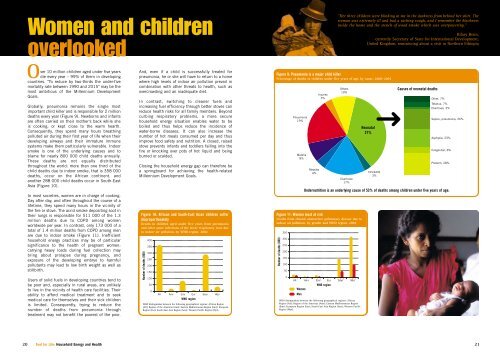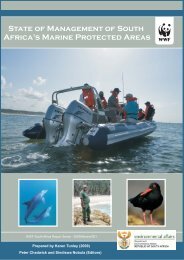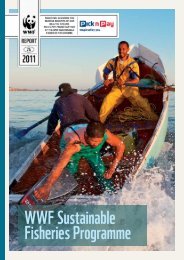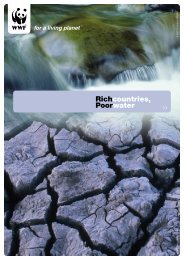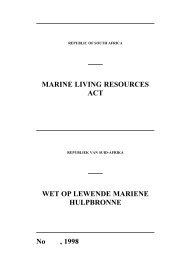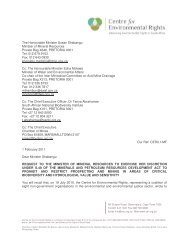Household Energy and Health - World Health Organization
Household Energy and Health - World Health Organization
Household Energy and Health - World Health Organization
Create successful ePaper yourself
Turn your PDF publications into a flip-book with our unique Google optimized e-Paper software.
Women <strong>and</strong> childrenoverlookedOver 10 million children aged under five yearsdie every year – 99% of them in developingcountries. "To reduce by two-thirds the under-fivemortality rate between 1990 <strong>and</strong> 2015" may be themost ambitious of the Millennium DevelopmentGoals.Globally, pneumonia remains the single mostimportant child killer <strong>and</strong> is responsible for 2 milliondeaths every year (Figure 9). Newborns <strong>and</strong> infantsare often carried on their mother's back while sheis cooking, or kept close to the warm hearth.Consequently, they spend many hours breathingpolluted air during their first year of life when theirdeveloping airways <strong>and</strong> their immature immunesystems make them particularly vulnerable. Indoorsmoke is one of the underlying causes <strong>and</strong> toblame for nearly 800 000 child deaths annually.These deaths are not equally distributedthroughout the world: more than one third of thechild deaths due to indoor smoke, that is 358 000deaths, occur on the African continent, <strong>and</strong>another 288 000 child deaths occur in South-EastAsia (Figure 10).In most societies, women are in charge of cooking.Day after day, <strong>and</strong> often throughout the course of alifetime, they spend many hours in the vicinity ofthe fire or stove. The acrid smoke depositing soot intheir lungs is responsible for 511 000 of the 1.3million deaths due to COPD among womenworldwide per year. In contrast, only 173 000 of atotal of 1.4 million deaths from COPD among menare due to indoor smoke (Figure 11). Inefficienthousehold energy practices may be of particularsignificance to the health of pregnant women:carrying heavy loads during fuel collection maybring about prolapse during pregnancy, <strong>and</strong>exposure of the developing embryo to harmfulpollutants may lead to low birth weight as well asstillbirth.Users of solid fuels in developing countries tend tobe poor <strong>and</strong>, especially in rural areas, are unlikelyto live in the vicinity of health care facilities. Theirability to afford medical treatment <strong>and</strong> to seekmedical care for themselves <strong>and</strong> their sick childrenis limited. Consequently, trying to reduce thenumber of deaths from pneumonia throughtreatment may not benefit the poorest of the poor.And, even if a child is successfully treated forpneumonia, he or she will have to return to a homewhere high levels of indoor air pollution prevail incombination with other threats to health, such asovercrowding <strong>and</strong> an inadequate diet.In contrast, switching to cleaner fuels <strong>and</strong>increasing fuel efficiency through better stoves canreduce health risks for all family members. Beyondcurbing respiratory problems, a more securehousehold energy situation enables water to beboiled <strong>and</strong> thus helps reduce the incidence ofwater-borne diseases. It can also increase thenumber of hot meals consumed per day <strong>and</strong> thusimprove food safety <strong>and</strong> nutrition. A closed, raisedstove prevents infants <strong>and</strong> toddlers falling into thefire or knocking over pots of hot liquid <strong>and</strong> beingburned or scalded.Closing the household energy gap can therefore bea springboard for achieving the health-relatedMillennium Development Goals.Figure 10: African <strong>and</strong> South-East Asian children sufferdisproportionatelyDeaths in children aged under five years from pneumonia<strong>and</strong> other acute infections of the lower respiratory tract dueto indoor air pollution, by WHO region, 2002400350300250200150100500Afr Amr Emr Eur Sear WprWHO regionWHO distinguishes between the following geographical regions: African Region(Afr); Region of the Americas (Amr); Eastern Mediterranean Region (Emr); EuropeanRegion (Eur); South-East Asia Region (Sear); Western Pacific Region (Wpr).Number of deaths (000)Figure 9: Pneumonia is a major child killerPercentage of deaths in children under five years of age, by cause, 2000–2003Pneumonia19%Malaria8%Measles4%Injuries3%"Her three children were blinking at me in the darkness from behind her skirt. Thewoman was extremely ill <strong>and</strong> had a racking cough, <strong>and</strong> I remember the blacknessinside the home <strong>and</strong> the stench of wood smoke which was overpowering."Others10%Diarrhoea17%Hilary Benn,currently Secretary of State for International Development,United Kingdom, reminiscing about a visit to Northern EthiopiaNeonatal37%HIV/AIDS3%Causes of neonatal deathsOther, 7%Tetanus, 7%Diarrhoea, 3%Sepsis, pneumonia, 26%Asphyxia, 23%Congenital, 8%Preterm, 28%Undernutrition is an underlying cause of 53% of deaths among children under five years of age.Figure 11: Women most at riskDeaths from chronic obstructive pulmonary disease due toindoor air pollution, by gender <strong>and</strong> WHO region, 2002Number of deaths (000)350300250200150100500Afr Amr Emr Eur Sear WprWHO regionWomenMenWHO distinguishes between the following geographical regions: AfricanRegion (Afr); Region of the Americas (Amr); Eastern Mediterranean Region(Emr); European Region (Eur); South-East Asia Region (Sear); Western PacificRegion (Wpr).20 Fuel for Life: <strong>Household</strong> <strong>Energy</strong> <strong>and</strong> <strong>Health</strong>21


